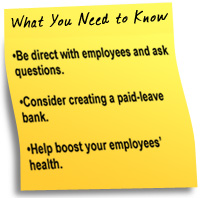 In large organizations—like Starbucks—if one employee doesn’t show up, it barely causes a blip on the radar. But if a business owner has five employees and one calls in for the day, that means 20 percent of his workforce is missing. In other words, absenteeism hits small businesses harder than it hits big ones.
In large organizations—like Starbucks—if one employee doesn’t show up, it barely causes a blip on the radar. But if a business owner has five employees and one calls in for the day, that means 20 percent of his workforce is missing. In other words, absenteeism hits small businesses harder than it hits big ones.
In 2005, absenteeism cost businesses $660 per employee, up from $610 in 2004, according to the 2005 CCH Unscheduled Absence Survey. “These are direct costs associated with absenteeism—that is, the payroll costs,” says Lisa Franke, SPHR, a workplace analyst for CCH. “But there are also indirect costs: For example, you might have to hire a temp worker or pay another employee overtime. Also, there’s an impact on your sales if you can’t meet your customers’ demands, and absenteeism affects employee morale. It's a big domino effect when someone doesn’t show up for work.”
Employees call in sick when they’re, well, sick. But according to the CCH survey, personal illness accounts for only 35 percent of unscheduled absences. The other 65 percent of absences are due to reasons like family issues, personal needs, an entitlement mentality and stress.
Don’t let absenteeism bring your business down. Here are six ways to keep employees on the job:
1. Just Ask
If you’re wondering why an employee has been calling in, why not ask? “Employees may not always answer honestly, but some people who speak freely may tell you that the work is boring or they don’t like their boss,” says Frank Kuzmits, Ph.D., a professor of management at the University of Louisville. You can also ask employees for their feedback in exit interviews, where they may feel more comfortable to speak freely. Your employees’ comments will let you know whether there’s something you need to change in the workplace, from an unpleasant atmosphere to an abusive supervisor or colleague.
And don’t just question the employees with a poor attendance record. “There’s no reason you can’t periodically sit down with people and ask why they come in regularly,” Kuzmits says. This will let you know what is working—so you can do more of it.
2. Take It to The Bank
Many unscheduled absences are due to issues such as sick family members, doctor appointments and stress. According to the CCH study, one of the most effective ways to combat this type of absenteeism is through a paid-leave bank. Instead of offering sick days, vacation days and so on, the employer offers a set number of paid-leave days that an employee can use for any reason. “A paid-leave bank promotes scheduled as opposed to unscheduled absences,” says Franke. “What’s troublesome about unscheduled absences is that they hit employers at the last minute. With a paid-leave bank, employees don’t have to call in in the morning and make up an excuse, and the business owner can take steps to have things covered.”

Also, when employers transition from a traditional sick-leave program to a paid-leave bank, they often trim the total number of days offered by two or three days, which saves them money. “If employees look at it they may notice, but they appreciate the flexibility so they see it as a benefit,” says Franke.
3. Get Well Soon
If illness-related absences are making your bottom line look sick, look into ways to enhance your employees’ health. You could create an on-site fitness center or subsidize your employees’ gym memberships. You can also hire nutritionists, personal trainers and other health specialists to come into the workplace and give presentations on healthy living. Call your health insurance provider to see what it offers in the way of preventive care. If some of your employees smoke, encourage them to quit by offering financial rewards, such as $50 or $100, if they kick the habit. It sounds like a pricy program, but you’ll save in the long run: “Research shows that people who smoke have more absences,” says Kuzmits.
4. Hire Right
Stop absenteeism before it happens by hiring the right employees. During the interview, “discuss the values of the individual and the business,” says Ray Silverstein, president of the small business network PRO, President’s Resource Organization. “Ask the candidate what their beliefs are regarding absenteeism, and tell the candidate that it’s a major criteria that you judge your employees by, and that excessive absenteeism is a cause for dismissal.”
The best predictor of future performance is past performance, says Kuzmits, so be sure to call the applicant’s references. Many employers are afraid to check (and give) references for legal reasons, but, says Kuzmits, “There’s no law that prevents an employer from communicating to another employer a verifiable, documented performance history. You shouldn’t have a problem asking about attendance because most professionally run companies will have records on how much people showed up for work.”

5. Motivate Them
According to the CCH study, businesses that were rated as having a good or very good morale had a 1.5 percent rate of unscheduled absences, while the rate for businesses with poor or fair morale was 3.2 percent—more than double. It makes sense: Happier employees are more likely to show up to work. You don’t need to buy into those pricey incentive programs touted by consultants to increase employee morale. “Look at your managers [to make sure they treat employees well], allow employees more decision-making authority, and recognize and reward your employees,” suggests Franke. Even a Friday pizza party or free movie tickets to say thanks for a job well done can boost morale.
6. Create Peer Pressure
Nothing motivates an employee to improve like peer pressure, says Silverstein. He suggests offering an incentive to all employees if absenteeism is kept below a certain amount. Find a reward that your employees will be excited about, i.e., not a pen engraved with the company name, and they’ll pull together to reduce absenteeism.


 In large organizations—like Starbucks—if one employee doesn’t show up, it barely causes a blip on the radar. But if a business owner has five employees and one calls in for the day, that means 20 percent of his workforce is missing. In other words, absenteeism hits small businesses harder than it hits big ones.
In large organizations—like Starbucks—if one employee doesn’t show up, it barely causes a blip on the radar. But if a business owner has five employees and one calls in for the day, that means 20 percent of his workforce is missing. In other words, absenteeism hits small businesses harder than it hits big ones.
